So, you’re looking to protect your new car with a ceramic coating – but are struggling with investing in ceramic pro products and installation vs the DIY ceramic coating option. Don’t worry, you’re not alone.
Choosing a paint protection product or mode of application is one of the most important decisions a car enthusiast will make.
On one hand, you can opt for a high-quality do-it-yourself nano-ceramic coating, invest a little elbow grease, and produce good results. Or, pay for a professional to prep and apply a professional-grade ceramic coating – with sometimes longer-lasting results.
The struggle is indeed real – so, which paint coating is the best option?
As much as we’d like to point you in one, particular direction, that’s not really our style. Instead, let’s break down the facts about Ceramic professional-grade products and installation procedures, some of the top brands of ceramic pro coatings, and the pros and cons of these fantastic products.
The Process for Installing Professional Ceramic Coating Products
A professional-grade ceramic coating requires a lot of preparation and application time. It’s usually a five-day process, from start to finish (including the time to strip old wax, polish, and other imperfections). In some instances, the professional ceramic coating installation expert will recommend paint correction (which can extend the process even more).
Detailed washing and clay bar treatment
Due to the complexity of the professional-grade ceramic coating, the preparation work is much more intense than a DIY ceramic coating. Like the DIY option, the prep begins with a detailed washing and clay bar treatment. It’s important to remove brake dust or other contaminants from the vehicle’s paint before applying any product.
1. Use deionized water and degreasers.
However, unlike the DIY solution, a professional installation only uses deionized water and specialized equipment to reduce the potential for any scratching. They also use chemical degreasers to remove any oil, road grime, or grease.
2. Air-dried with compressed air
Finally, the vehicle is air-dried with compressed air that has been filtered, so that no contaminants are spread onto the freshly pepped surface.
Paint correction
After the wash and treatment are done, they will move towards any paint correction. A professional protective coating is much more sensitive to existing scratches, rock chips and swirl marks, so they’ll need to complete at least some paint correction for optimal results.
Applying the ceramic coating
The complex part of installing the professional ceramic coating is applying the product. Since there are several brands and unique types of professional coating, each one requires individual recommended steps. However, the general process follows these guidelines:
1. A primer polish is added:
Most products like Opti-Coat, or Modesta will begin the application process with a primer polish being added. This helps to improve the shine underneath the coating.
2. The vehicle is moved to a sealed installation booth:
Once the polish has been added, the vehicle is moved to a completely sealed installation booth of an auto detailing company; much more detailed than a professional paint booth. This is done to completely remove the potential of dust or any contaminants touching the ceramic coating or vehicle surface.
3. Wipe down the body with alcohol and water:
Before actually applying the product, the professional installers will wipe down the body with alcohol and water-based solution.
4. First layer:
The first layer of ceramic pro coating is then applied in two-foot by two-foot sections. The process is tedious and time-consuming. In fact, it can take up to 8 hours or more to complete an average-sized car.
5. Additional layers:
Again, depending on the quality of the professional-grade ceramic coating (or the package option you purchase) additional layers of coating will be installed in a similar fashion as the primary.
6. Heat Baking:
Most professional coatings require heat-treated baking in order to stimulate the active ingredients for accurate adhesion. This is completed by using the heat-lamp method, where direct heat up to 150-degrees helps to expedite the curing process.

When the product has been completely installed, the vehicle will take some time to cure. Most professional installers will keep the vehicle overnight, then release it back to the owner.
Like a high-quality DIY ceramic coating, the professional-grade will require 48 hours until the vehicle should be washed. However, unlike the DIY, the professional-grade will take up to 30 days to completely harden to provide ceramic pro rain protection.
Warranties and Packages of Professional Grade Ceramic Coatings
A major reason why many luxury car owners choose to invest in professional-grade ceramic coatings is due to the warranty options available. While many DIY Nano-ceramic coatings can last up to five years in some cases, they are not backed by a predetermined length of time “guarantee”.
Some professional coatings will have this peace of mind protection – but there is a slight catch.
Most professional installation centers offer their customers ceramic pro packages. Let’s use a popular brand of professionally installed ceramic coatings for an example. We’ll keep the name to ourselves to protect the innocent.

Gold Package:
This particular company offers what they call a “gold package” which offers “permanent protection with a lifetime warranty.” To accomplish this level of performance, the installer must apply at least 4 layers of ceramic pro, top-of-the-line coating – and a layer of a ‘top-coat’ product. The pricing for this premium package will vary based on the size of the vehicle, and prep work required.
Silver Package:
The next level ‘down’ is a 5-year warranty plan. With this warranty, only (1) layer of their Premium 9H product is needed plus (1) layer of their “light” product as a top coating.
Bronze Package:
This is the basic protection package, that includes (1) layer of their “light” formulation. It’s not a 9H hardness formula but is guaranteed for up to 24-months.
Here is the catch – it’s nearly impossible to determine what is ‘guaranteed’ – as it will vary based on the brand, installation center, and multiple variables (such as the amount of prep work, paint correction, and more).
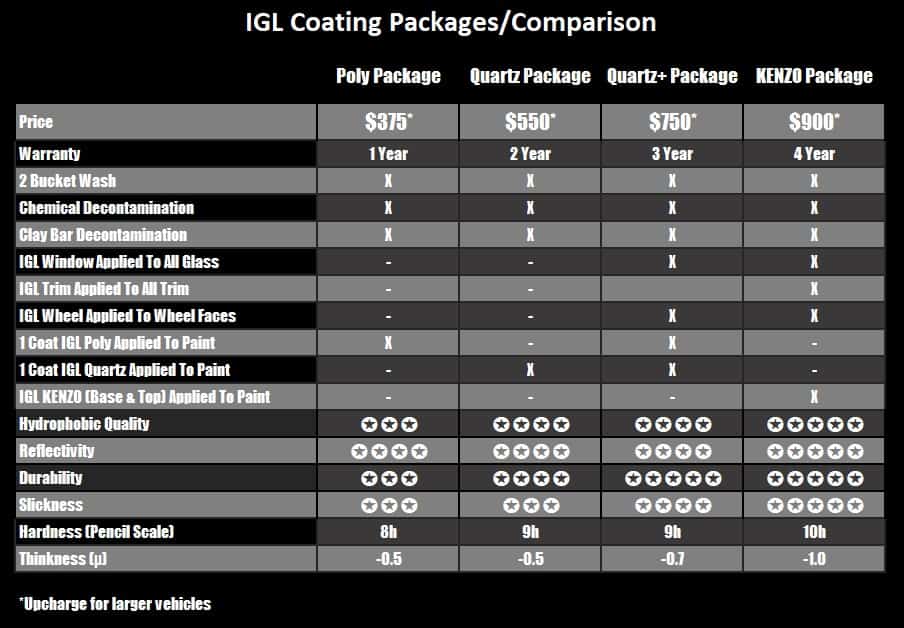
If you’re going to choose a professionally applied ceramic coating, make sure to clarify exactly what is covered with the installer and manufacturer.
What Are the Top 3 Professional Ceramic Coating Brands?
In the ceramic pro industry, there are three, general leaders in the clubhouse. This isn’t a ranking of the best, just a general list of three of the most popular on the market.
Opti-Coat PRO
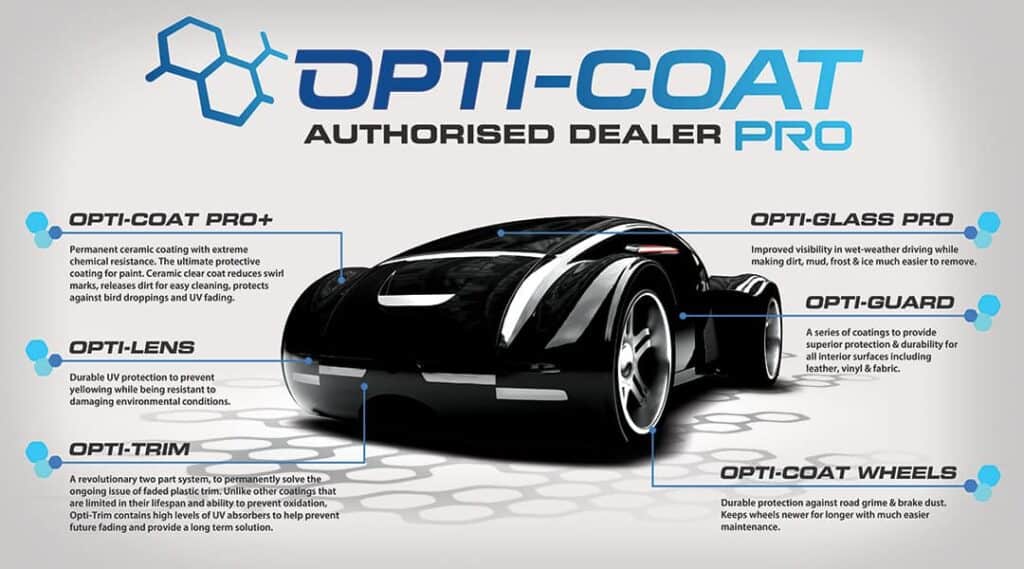
Opti-Coat is a product that is offered by Optimum Polymer Technologies and is only offered for professional installation at certified facilities. It’s a single-installation product and protects the vehicle paint surface permanently.
Properties of Opti-Coat PRO
Opti-Coat PRO is a clear, ceramic polymer coating that will chemically bond to a factories clear coat. It’s applied via a foam applicator and pad. Professional installers will apply it in 2 x 2-foot blocks or sections.
Application process
During this application process, a liquid medium in the formula will evaporate, which then requires quick and complete removal during the “flashing” phase. This is why its time consuming and only applied by professionally trained installation technicians.
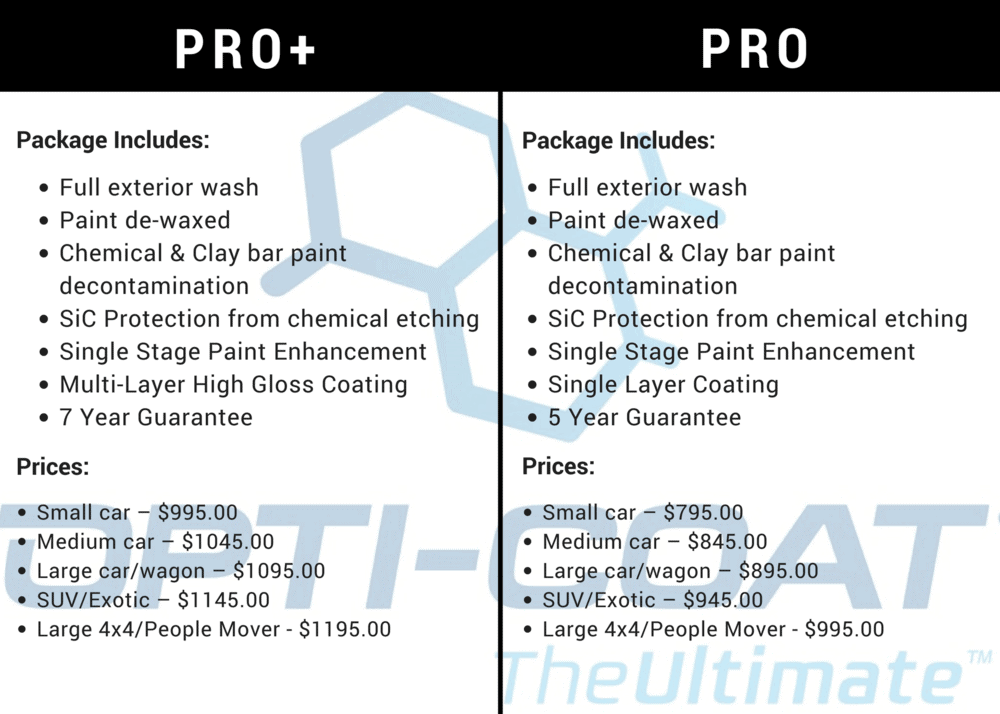
The final step is the curing process, which begins with a 150-degree ‘baking’ period. After about 30 minutes, it is dry to the touch and actually is ready for exposure to water about an hour later. However, it will take up to 60-days to fully cure. Depending on the installation type, this product can last up to five years and does provide some serious color depth and high gloss finish.
Modesta Glass Coating

Modesta Glass Coating is a Japanese formulation of professional coating with nine products within the line; ranging from the basic BC-01 to premium BC-09 (without a BC-07 variant), and a Paul Dalton Private Label (named after one of the inventors of the product).
Properties of Modesta Glass Coating
The hard glass-like surface is created through a proprietary-blend of high-grade silicon and other inorganic components. Some of their products utilize titanium dioxide, which makes it completely resistant to oxidation.
Application process
They offer three different ways of application – each of which requires certification and training and can only be completed by a professional or authorized dealer.
1. Wet Application
This is a slight alteration of the traditional method of installing most automotive ceramic coatings. However, the unique touch is wiping off the surface with a wet microfiber cloth, which activates the hardening process. BC-01 through BC-04 products are installed in this manner and requires a heat-lamp curing for up to an hour.
2. Dry Application
Dry application uses an applicator with the liquid glass coating. Prior to applying the BC-05 or PD Private Label product, a primer-agent (P-01A) is first applied as a base coat. After this application, the primer is wiped with a microfiber cloth, then a top-layer or coat of the product is applied. This method cures without assistance from heat lamps.
3. Spray Application
The final application is a spray method, where the BC-06 compound is applied with a paint gun and nitrous oxide propellant (which actually sounds rather bitchin). This method requires multiple layers of spray and will use a similar curing process as the wet application.
Ceramic Pro
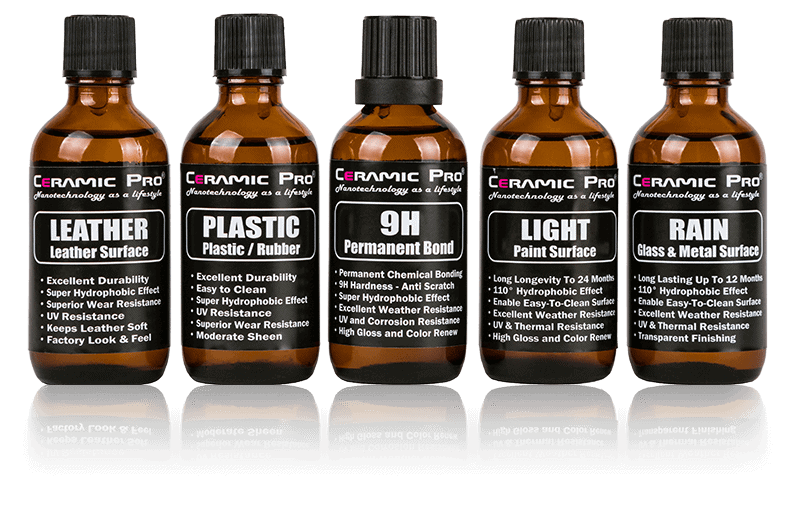
With regards to bandwidth, Ceramic Pro or its parent company Nanoshine Ltd is the leader in the industry. It’s available in 70 different countries, installed by more than 5,000 authorized dealers, and is applied to more than 100,000 vehicles each month.
Their product line ranges from automotive, air and marine and protects multiple surfaces including paint, alloy, glass, ceramic pro leather, fabric, rubber, and plastic.
Their automotive paint products are branded under the Ceramic Pro line and usually involves the use of two, unique products – a base and top-layer coating.
1. Ceramic Pro 9H
This is their premium product, that provides the hardest level of protection (9H on the scale). It is often applied in multiple coatings, with additional product guarantees and warranties dependent upon the amounts of layers installed. Four coats of this product plus a single coat of their Pro Light product can receive a “lifetime warranty”.
Ceramic Pro Light (Lighter version)
The Ceramic Pro Light is a top-coat or a lighter version of their premium product. It’s not as durable or strong as the Pro 9H product but does produce exceptional shine enhancement and hydrophobic properties. It has a life expectancy of roughly two-years.
2. Ceramic Pro Sport
Pro Sport is Ceramic Pro’s industrial product. It is used as an enhancement or product extender after the Ceramic Pro 9H or Light has been previously applied. It lasts about 6 to 12 months.
What are the Pros and Cons of Professional Ceramic Coating?
As you can see based on the products listed above, professional-grade ceramic coatings can offer superior protection against UV rays, scratches, anti-graffiti, bug splatters, bird droppings, and more. Plus, sometimes having a professional automotive car care expert take the time to prep, install, and cure the coating is just easier than doing it yourself.
That being said, here are some of the PROS and CONS of using a professional ceramic coating.
PROS
Minimal effort for the car owner:
Having a professional detailer or authorized installation center do all the prep work, application and curing is the most user-friendly option for superior paint protection. You simply need to take the car to the dealer, set up the appointment, and they’ll do all the work.
Upgradable packages offer “lifetime warranties”:
Some products offer lifetime warranties, which means you’ll never have to reapply or pay for extra paint protection.
Superior shine:
Professional Ceramic coatings can produce exceptional shine and hydrophobic properties.
Minimal upkeep:
Assuming the installation expert does a good job with the prep work and application, a ceramic pro product will require less upkeep vs. some DIY products.
CONS
1. Costly:
When compared to most high-quality DIY Nano-Ceramic coatings, the professional option is more costly. Most of them range from $1,000 to $2,500 based on the product, how many applications, and desired warranty.
2. Buyer Beware:
Just like the DIY ceramic coating industry, buyers should be aware of the products and installation companies doing the work. Some due diligence will help you find the right installation expert who uses the best products.
3. Hard to determine warranty protection:
Warranties on ceramic coating products are hard to determine. Some are based on manufacturer requirements or set by the installation company. Make sure to clarify before you buy it.
What are the Pros and Cons of DIY Nano Ceramic Coatings?
The other option that offers similar levels of hardness and protection as the ceramic pro installed products are high-quality DIY ceramic coating products. The do-it-yourself formula is different than the pro-grade stuff, as it’s designed for improved installation, requires slightly less prep work, and can be easier to install.
However, like professional products, there are some PROS and CONS to consider.
PROS
1. Less Costly:
While the average car will run you more than $1,000 to have a professional install, a high-quality DIY nano-ceramic coating will cost about 90% less.
2. Superior Hydrophobic Properties:
DIY ceramic coatings can produce exceptional shine and hydrophobic properties – just like the professional stuff.
3. Similar length of service:
On average, the professional and DIY products offer the same level of protection for the same length of time.
4. Exceptional Customer Support:
Well – from some companies at least.
CONS
1. It takes effort to prep the vehicle:
There is no way to sugar coat this if you want great results from any paint protection product, you’ll have to do some prep work. DIY ceramic kits are no different and can be labor-intensive. The quality of your paint surface will mainly determine how much prep work will be required.
2. Not for all cars:
If your paint’s clear coat is thin, a DIY ceramic coating is not going to help much. It’s really intended for newer cars with quality clear coat finishes.
3. Some really inferior products on the market:
Like the professional-grade coatings, there are some that are better than others. The DIY segment is packed with inferior products with over-exaggerated claims, so do your research before you purchase.
Fact-Checking Ceramic Professional Coating Myths

Let’s play a game. In this edition of True or False, we’ll outline some of the common myths about professional ceramic coatings and tell you whether it’s TRUE or FALSE – or… (insert your favorite colorful metaphor).
Impervious to Scratching: FALSE
This is true of all ceramic coatings. While they can help to reduce the potential of scratching, they are not scratch proof.
Rock Chip Resistant: FALSE
Another flat out lie about ceramic coatings. A rock of virtually any size at speed hitting your car’s paint, glass, or other area is going to cause some damage.
Chemical Resistant: TRUE
While some claims are outlandish or marketing spin, this one is actually true of ceramic professional coatings and high-quality DIY products. While they are not bullet-proof, they can help reduce chemicals from damaging paint and clear coats.
Self-Healing: MEH
So, we’ll mark this one “meh” mainly because there is some truth to this myth. There are some formulas that contain a polymer that helps some minor scratches to ‘disappear’. But, most of the time, the ceramic coating will allow you to ‘lightly buff’ some minor scratches. They are NOT as good as PPF in this department.
The Lighter Fluid and Lighter Test – MARKETING BULLSHIT
So, I don’t know who came up with this ‘trick’ but it’s just ridiculous. Simple carnauba wax can deflect the old lighter-strike and protect the paint surface from a low-temperature quick flame from lighter fluid.
Warranties – GET IT IN WRITING
You’ll notice that we listed some of the ‘warranties’ for professional-grade ceramic coatings and installation packages. What you’ll find incredibly difficult to find are the details. If the dealer or installer offers a warranty or guarantee, get it clarified – IN WRITING. And make sure they clarify with you the specifics, such as inclusions or restrictions.
No Need to Use Car Wax Ever Again – MOSTLY TRUE
A ceramic coating produces an exceptional shine and does a superior job of protecting your paint’s clear coat. And while it’s ‘working’ – there is no need to wax the vehicle. However, it is likely that it will eventually wear out. While there are some professional coatings (or application packages) that offer a lifetime guarantee, most of them have a life expectancy.
What’s the Verdict – Ceramic Pro vs DIY Kits?

It all breaks down to the level of work you’re willing to do. When you compare the best professional-grade ceramic coatings vs the best DIY ceramic coating kits – the quality of each is mainly based on prep work and application.
Letting a professional handle this task is convenient, but you’ll pay a premium price. For some consumers, it simply makes sense to opt for professionally installed products.
However, it also depends on your comfort level. If you want to undertake this task, make sure to purchase a high-quality and easy to install DIY Ceramic Coating product with an exceptional hydrophobic effect, from a company that offers superior customer support with easy to follow instructions.





![[2024 Guide] The Truth about Ceramic Pro vs DIY Ceramic Coatings](http://avalonking.com/cdn/shop/articles/Ceramic-Pro-vs-DIY-Ceramic-Coatings.jpg?v=1651076354&width=1500)
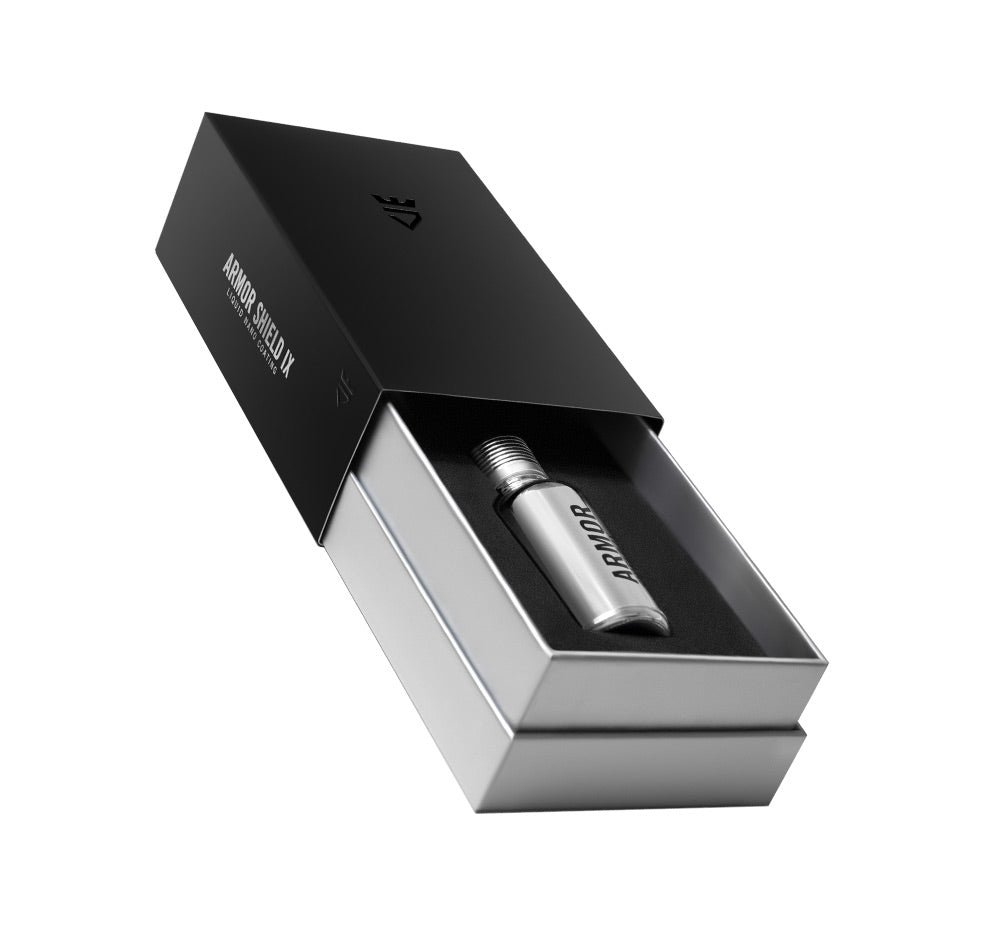
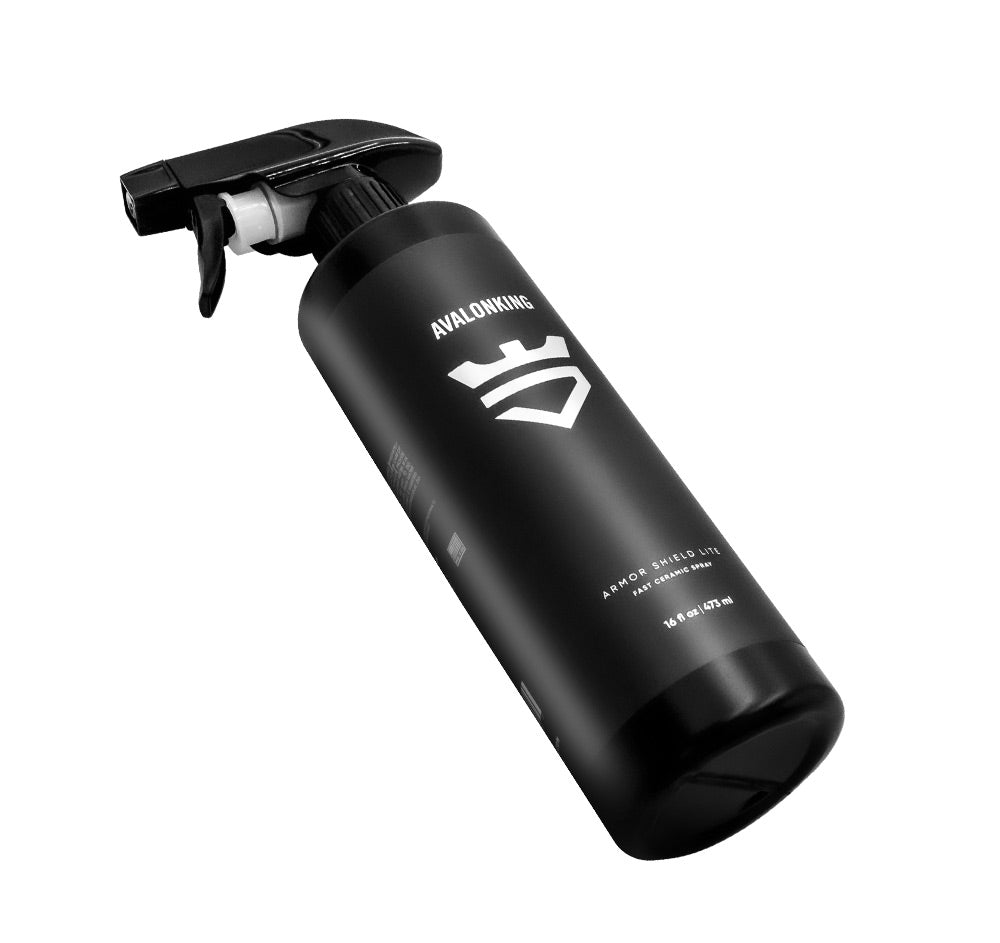



![[2023] Don't Buy CQuartz 3.0 Until you Read This!](http://avalonking.com/cdn/shop/articles/Armor-Shield-IX-vs-Cquartz-UK-3.0_1000x.jpg?v=1651076362)

23 comments
Greg
Once the ceramic coating reaches the end of its useful life on a car can it be reapplied?
Once the ceramic coating reaches the end of its useful life on a car can it be reapplied?
Tim Charlet
Hi Pete:
Thanks for the question. To be honest, what you’ve mentioned is one of the biggest misconceptions of ceramic coatings. Coatings adhere to a porous surface, not on top of each other. So, applying multiple layers doesn’t really benefit you. If you apply a ceramic coating, it’s best to NOT apply anything on top, as you’ll be losing a lot of the hydrophobic properties of the coating itself.
Hi Pete:
Thanks for the question. To be honest, what you’ve mentioned is one of the biggest misconceptions of ceramic coatings. Coatings adhere to a porous surface, not on top of each other. So, applying multiple layers doesn’t really benefit you. If you apply a ceramic coating, it’s best to NOT apply anything on top, as you’ll be losing a lot of the hydrophobic properties of the coating itself.
Pete
Can ceramic coating be reapplied to build up the layers of protection? Will using a topcoat, such as F11, provide additional protection?
Can ceramic coating be reapplied to build up the layers of protection? Will using a topcoat, such as F11, provide additional protection?